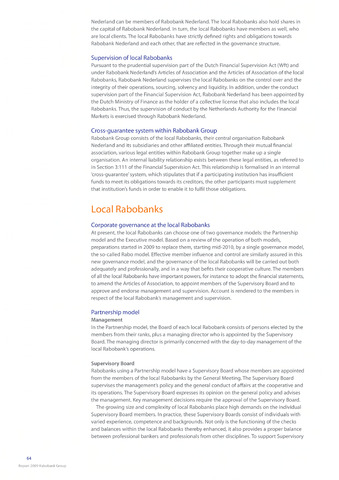Local Rabobanks
Nederland can be members of Rabobank Nederland. The local Rabobanks also hold shares in
the capital of Rabobank Nederland. In turn, the local Rabobanks have members as well, who
are local clients. The local Rabobanks have strictly defined rights and obligations towards
Rabobank Nederland and each other, that are reflected in the governance structure.
Supervision of local Rabobanks
Pursuant to the prudential supervision part of the Dutch Financial Supervision Act (Wft) and
under Rabobank Nederland's Articles of Association and the Articles of Association of the local
Rabobanks, Rabobank Nederland supervises the local Rabobanks on the control over and the
integrity of their operations, sourcing, solvency and liquidity. In addition, under the conduct
supervision part of the Financial Supervision Act, Rabobank Nederland has been appointed by
the Dutch Ministry of Finance as the holder of a collective license that also includes the local
Rabobanks. Thus, the supervision of conduct by the Netherlands Authority for the Financial
Markets is exercised through Rabobank Nederland.
Cross-guarantee system within Rabobank Group
Rabobank Group consists of the local Rabobanks, their central organisation Rabobank
Nederland and its subsidiaries and other affiliated entities. Through their mutual financial
association, various legal entities within Rabobank Group together make up a single
organisation. An internal liability relationship exists between these legal entities, as referred to
in Section 3:111 of the Financial Supervision Act. This relationship is formalised in an internal
'cross-guarantee'system, which stipulates that if a participating institution has insufficient
funds to meet its obligations towards its creditors, the other participants must supplement
that institution's funds in order to enable it to fulfil those obligations.
Corporate governance at the local Rabobanks
At present, the local Rabobanks can choose one of two governance models: the Partnership
model and the Executive model. Based on a review of the operation of both models,
preparations started in 2009 to replace them, starting mid-2010, by a single governance model,
the so-called Rabo model. Effective member influence and control are similarly assured in this
new governance model, and the governance of the local Rabobanks will be carried out both
adequately and professionally, and in a way that befits their cooperative culture. The members
of all the local Rabobanks have important powers, for instance to adopt the financial statements,
to amend the Articles of Association, to appoint members of the Supervisory Board and to
approve and endorse management and supervision. Account is rendered to the members in
respect of the local Rabobank's management and supervision.
Partnership model
Management
In the Partnership model, the Board of each local Rabobank consists of persons elected by the
members from their ranks, plus a managing director who is appointed by the Supervisory
Board. The managing director is primarily concerned with the day-to-day management of the
local Rabobank's operations.
Supervisory Board
Rabobanks using a Partnership model have a Supervisory Board whose members are appointed
from the members of the local Rabobanks by the General Meeting. The Supervisory Board
supervises the management's policy and the general conduct of affairs at the cooperative and
its operations. The Supervisory Board expresses its opinion on the general policy and advises
the management. Key management decisions require the approval of the Supervisory Board.
The growing size and complexity of local Rabobanks place high demands on the individual
Supervisory Board members. In practice, these Supervisory Boards consist of individuals with
varied experience, competence and backgrounds. Not only is the functioning of the checks
and balances within the local Rabobanks thereby enhanced, it also provides a proper balance
between professional bankers and professionals from other disciplines. To support Supervisory
64
Report 2009 Rabobank Group

